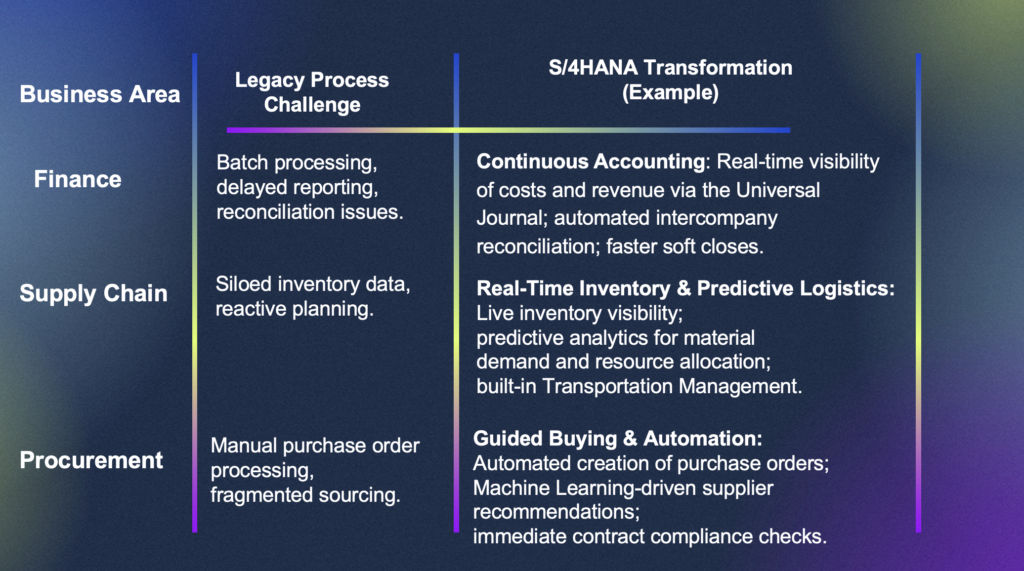
The move to SAP S/4HANA, SAP’s fourth generation enterprise resource planning (ERP) suite, is more than a simple IT upgrade; it is a fundamental shift toward an intelligent enterprise. For organizations, this journey encompasses two interconnected pillars: the technical migration and the business transformation through process re-design. A successful project requires treating both as equally critical components of a holistic strategy.
1. The Technical Migration: Choosing Your Path
The technical part of the journey involves moving your existing data and systems to the new S/4HANA environment, which is powered by the in-memory SAP HANA database. Companies generally choose one of three main approaches, each with its own implications for business process transformation.
A. System Conversion (Brownfield)
- What it is: Converting an existing SAP ERP (e.g., SAP ECC) system directly to S/4HANA in a single step, preserving historical data, configuration, and most existing business processes.
- Transformation Impact: This approach is typically IT-driven and focuses on speed and minimal disruption. While it retains processes, it necessitates a thorough Custom Code Check to ensure compatibility with the new simplified data model. Process re-design is often optional or phased in later after the technical switch is complete.
B. New Implementation (Greenfield)
- What it is: Starting from scratch with a clean, new S/4HANA installation. Only master data and key transactional data are migrated, and business processes are re-built from the ground up.
- Transformation Impact: This is the most business-driven approach. It allows the organization to completely rethink, simplify, and align processes with SAP Best Practices and the full capabilities of S/4HANA. It’s ideal for companies with heavily customized or outdated legacy systems.
C. Selective Data Transition (Bluefield)
- What it is: A hybrid approach where specific parts of the legacy landscape (e.g., only certain business units, selected historical data, or a system consolidation) are moved to the new S/4HANA environment.
- Transformation Impact: This offers flexibility to consolidate multiple legacy systems or to selectively re-design processes in critical business areas while preserving other parts, balancing speed with strategic transformation.
2. The Business Transformation: Re-designing for Intelligence
Regardless of the technical path, the true value of S/4HANA is unlocked by the accompanying business transformation. This involves re-designing processes to leverage the suite’s new features and capabilities, moving the enterprise from a transactional system to an intelligent ERP.
Key S/4HANA Capabilities Driving Transformation
The redesign is driven by S/4HANA’s foundational architectural and functional enhancements:
- Real-Time Data & Simplified Data Model: The in-memory HANA database eliminates the need for separate aggregation and reporting tables (e.g., the introduction of the Universal Journal in Finance). This enables instant access to operational data, transforming processes like the month-end close from a prolonged event to a continuous activity.
- Embedded Analytics: Analytics are no longer separate, backward-looking reports. They are integrated directly into the core processes and displayed via the SAP Fiori user experience, allowing users to make real-time, data-driven decisions at the point of action.
- Intelligent Automation (AI/ML): S/4HANA’s architecture supports embedding Machine Learning and Artificial Intelligence. This facilitates the automation of tedious, high-volume tasks in areas like Invoice Processing, Predictive Maintenance, and Demand Forecasting, leading to improved efficiency and reduced errors.
- Simplified User Experience (Fiori): The shift to the Fiori interface provides a personalized, role-based, and intuitive user experience across devices, boosting user productivity and reducing training overhead.
Process Re-design in Practice
Business process re-design focuses on exploiting these capabilities. This involves a fundamental shift in mindset: instead of asking, “How do we map our old process to the new system?” the question becomes, “What is the best-in-class, most efficient way to run this process, leveraging S/4HANA’s intelligence?”

3. A Successful Transformation: The Project Blueprint
A successful S/4HANA project hinges on a rigorous, structured methodology that prioritizes both technical execution and organizational adoption. The SAP Activate methodology is commonly used, guiding the project through key phases:
- Discover: Initial assessment and business case development.
- Prepare: Project planning, team setup, and technical readiness checks (e.g., custom code analysis).
- Explore: The critical transformation phase. Define the “To-Be” processes, aligning them with S/4HANA’s capabilities and SAP Best Practices. This is where the core re-design and gap analysis take place.
- Realize: Configuration, development, data cleansing/migration, and rigorous testing.
- Deploy: Go-live preparation, final data cut-over, and cut-over activities.
- Run: Hypercare support and continuous process improvement post-go-live.
The Critical Role of Change Management
Since S/4HANA often introduces entirely new ways of working, an effective Organizational Change Management (OCM) program is vital. OCM is not just user training; it’s about helping employees understand the why behind the change, preparing them for their new roles, and fostering adoption of the simplified, intelligent processes. Neglecting the people side of the transformation can derail even the most technically flawless migration.
Bottom Line
The S/4HANA journey is thus a dual mandate: a technical migration to a new platform and a business transformation to an intelligent operating model. The reward for executing both successfully is a future-proof, data-driven enterprise equipped for the digital age.
Do you have any questions about Bolders Consulting Group’s services? Or, are you looking for more information regarding our solution development services? Contact Bolders today to learn how we can help transform your business with SAP technology!

